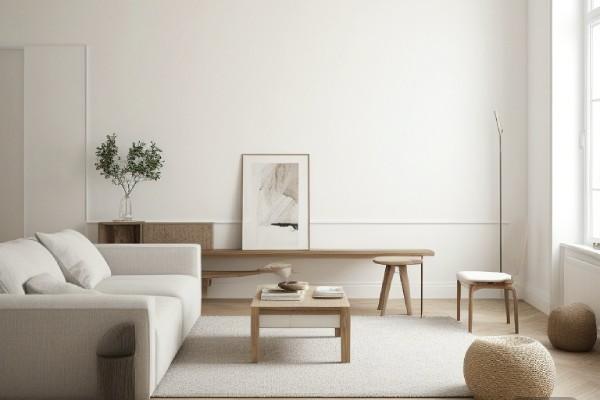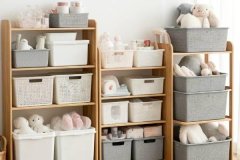How to organize your home for a clutter-free life
Organizing your home for a clutter-free life is not just about tidying up—it’s about creating systems that work for your lifestyle and help you maintain order effortlessly. Here are some unique and practical strategies to transform your home into a serene, clutter-free space:

1. Adopt a "Home Reset" Routine
-
Dedicate 10-15 minutes each evening to reset your home. This includes putting items back in their designated spots, wiping down surfaces, and preparing for the next day.
-
Make it a family activity by assigning small tasks to everyone in the household.
2. Implement the "One-Touch Rule"
-
The moment you touch an item, decide its fate: put it away, donate it, recycle it, or throw it away. This prevents piles from forming and keeps clutter at bay.
-
Apply this rule to mail, groceries, and everyday items.
3. Create "Drop Zones" for High-Traffic Areas
-
Designate specific spots near entryways for keys, wallets, bags, and shoes. Use trays, hooks, or small shelves to keep these items organized.
-
Add a charging station for devices to prevent cords from cluttering countertops.
4. Use the "80/20 Rule" for Belongings
-
Recognize that you likely use only 20% of your belongings 80% of the time. Identify the items you rarely use and consider donating, selling, or storing them elsewhere.
-
Focus on keeping only what adds value to your daily life.
5. Designate a "Clutter Amnesty Box"
-
Place a box in a central location for items that don’t have a home. At the end of the week, sort through the box and decide what to keep, donate, or discard.
-
This is a great way to prevent random items from piling up around the house.
6. Organize by Activity Zones
-
Group items based on their purpose and the activities they support. For example, create a coffee station in the kitchen, a crafting corner in the living room, or a workout area in the bedroom.
-
This ensures everything has a logical place and reduces the time spent searching for items.
7. Maximize Vertical Space
-
Use wall-mounted shelves, pegboards, or hanging organizers to free up floor and counter space. This is especially useful in small homes or apartments.
-
Store frequently used items at eye level and less-used items higher up.
8. Adopt a "No-Shopping" Challenge
-
Commit to a month (or longer) of not buying non-essential items. This helps you break the habit of accumulating unnecessary belongings and encourages creativity with what you already own.
-
Use this time to declutter and appreciate the items you have.
9. Create a "Paper Command Center"
-
Designate a spot for managing paperwork, such as bills, school forms, and mail. Use trays, folders, or a filing cabinet to sort documents into categories like "To Do," "To File," and "To Shred."
-
Go paperless whenever possible to reduce physical clutter.
10. Use Clear Storage Containers
-
Transparent bins or jars allow you to see what’s inside without opening them. This is especially helpful for pantry items, craft supplies, or seasonal decorations.
-
Label containers for added clarity and ease of use.
11. Establish a "One In, One Out" Rule
-
For every new item you bring into your home, let go of an old one. This applies to clothes, gadgets, toys, and even furniture.
-
This rule helps maintain balance and prevents clutter from creeping back in.
12. Declutter Digitally
-
Organize your digital life by deleting unused apps, organizing files into folders, and unsubscribing from unnecessary emails.
-
Regularly back up important files to an external drive or cloud storage to free up space on your devices.
13. Designate a "Maybe Box" for Sentimental Items
-
If you’re unsure about letting go of certain items, place them in a "Maybe Box" and store it out of sight. Revisit the box after 6 months—if you haven’t missed the items, it’s time to let them go.
-
This approach makes decluttering sentimental items less overwhelming.
14. Create a "Maintenance Schedule"
-
Break down cleaning and organizing tasks into daily, weekly, and monthly routines. For example:
-
Daily: Wipe down surfaces and reset common areas.
-
Weekly: Declutter one room or category (e.g., clothes, books).
-
Monthly: Deep clean and reorganize storage spaces.
-
-
Consistency is key to maintaining a clutter-free home.
15. Focus on Quality Over Quantity
-
Invest in fewer, high-quality items that you truly love and use regularly. This reduces the need for constant replacements and minimizes clutter.
-
Apply this mindset to furniture, clothing, kitchenware, and decor.
16. Celebrate Progress, Not Perfection
-
Organizing is an ongoing process, not a one-time event. Celebrate small wins, like clearing out a drawer or organizing a shelf.
-
Remember, the goal is to create a home that feels peaceful and functional, not picture-perfect.
By implementing these strategies, you can create a home that supports a clutter-free lifestyle and brings a sense of calm and order to your daily routine. Start small, stay consistent, and enjoy the transformative power of an organized space!
Achieving a clutter-free home is more than just tidying up; it’s about creating a living space that supports peace of mind, functionality, and joy. To organize your home for a clutter-free life, you need to adopt intentional habits, rethink your space layout, and implement smart storage solutions. Here’s a fresh approach to creating a clutter-free home:
1. Declutter by Category, Not by Room
Instead of focusing on a single room, tackle clutter by category. This method, inspired by the KonMari approach, helps you see how much of one type of item you have across your entire home.
- Clothing: Go through your wardrobe piece by piece, and ask yourself if each item sparks joy or serves a practical purpose.
- Books & Paperwork: Gather all your books and paperwork, then decide what you truly want to keep.
- Kitchen Items: Look at duplicates (e.g., multiple measuring spoons, excessive kitchen gadgets) and keep only what’s necessary.
- Sentimental Items: Keep only the items that hold deep emotional value, and let go of the rest.
2. Embrace the "One-In, One-Out" Rule
To prevent new clutter from accumulating, adopt a "one-in, one-out" rule for everything. For every new item you bring into your home—whether it’s a piece of clothing, a gadget, or a book—commit to donating or discarding an old item. This helps keep your home in a state of balance and prevents unnecessary buildup.
3. Use Vertical Space Efficiently
Don’t forget to utilize vertical space in your home. Installing shelves or floating cabinets can free up valuable floor space and reduce visual clutter. You can also hang hooks for coats, bags, or hats, and use pegboards for smaller items like kitchen tools, office supplies, or craft materials.
4. Create Defined Zones
Organize your living space into clear, functional zones that support how you live. Whether you live in a small apartment or a larger house, clear zoning keeps things organized and intentional:
- Entry Zone: Create a dedicated space for coats, shoes, and bags right inside the door to prevent clutter from spilling into other areas.
- Reading/Relaxation Zone: Set up a space that’s comfortable for reading or unwinding, with books neatly shelved and minimal distractions.
- Work Zone: If you work from home, create a zone for your desk and work supplies that is separate from other areas like the living or dining rooms.
Each zone should have a clear purpose and should be easily accessible.
5. Adopt Minimalist Storage Solutions
Invest in minimalist storage solutions that blend seamlessly into your home’s décor while keeping clutter out of sight. Look for:
- Multi-functional Furniture: Pieces like ottomans with hidden storage, or beds with drawers underneath, can help you stash away extra items.
- Baskets & Bins: Invest in neutral-colored bins or baskets to contain loose items like toys, remote controls, or mail. The key is choosing storage that’s easy to access and fits the aesthetics of your home.
- Drawer Dividers: For smaller spaces, dividers within drawers can keep items separated and prevent them from becoming a jumbled mess.
6. Implement the 30-Minute Daily Tidy-Up Habit
A major hurdle to maintaining a clutter-free home is the buildup of mess over time. To stay on top of it, set aside just 30 minutes a day for tidying up. This can be split into short bursts—such as 10 minutes in the morning, 10 minutes after lunch, and 10 minutes before bed. Tidying as you go can prevent clutter from accumulating in the first place.
7. Digitize Paperwork
One of the top contributors to clutter in the modern home is physical paperwork—bills, receipts, documents, etc. Consider going paperless where possible, such as signing up for online statements, and storing important documents digitally. For physical paperwork that needs to be kept, use a filing system to store it neatly and out of sight.
8. Adopt a “Minimalist Mindset”
Clutter often starts in our minds before it ends up in our homes. Begin by cultivating a minimalist mindset: buy only what you truly need, avoid impulse purchases, and let go of items that no longer serve a purpose. By becoming more mindful of what you bring into your space, you’ll naturally reduce clutter over time.
9. Utilize Hidden Storage
Hidden storage solutions can be a lifesaver in keeping your home organized while reducing the visual clutter. Consider:
- Storage Ottomans: Double as seating and hidden storage for blankets, toys, or remote controls.
- Under-bed Storage: Utilize the space beneath your bed with rolling bins or low-profile drawers.
- Storage Behind Doors: Add hooks, racks, or small shelves on the back of doors to store items like scarves, accessories, or shoes.
10. Curate Your Decor
Avoid over-decorating your space. While decorative items can add personality to a room, too many can create a sense of chaos. Select a few meaningful pieces that resonate with you, and rotate them occasionally to keep the room fresh. This ensures your decor enhances your space rather than contributing to clutter.
11. Seasonal Purging
At least twice a year, go through your belongings to purge items that no longer serve a purpose. This seasonal declutter will help you keep your possessions manageable and your space feeling light and organized. It’s also a great time to donate or sell things you no longer use.
12. Teach Household Members Good Habits
If you live with others, make sure everyone in the household is on board with maintaining a clutter-free home. Set clear expectations for everyone to put things away after use, and encourage regular cleaning habits. This creates a collective sense of responsibility and ensures your home stays organized long-term.
13. Optimize Your Closet Space
Closets can become cluttered quickly if not managed well. Maximize your closet storage with:
- Double-Hang Rods: Install an extra rod at the bottom of your closet to create more hanging space for shorter items like shirts and pants.
- Slimline Hangers: Use thin hangers to create more space and keep your clothes organized.
- Clear Bins: Store seasonal clothing or shoes in clear bins so you can easily identify what’s inside without having to dig.
14. Routine Decluttering
Make decluttering a regular part of your routine—whether it's monthly, quarterly, or yearly. The more often you review what you own and get rid of unnecessary items, the easier it will be to maintain a clutter-free home. A well-curated space is easier to keep tidy than one that’s constantly overstuffed with belongings.
15. Keep Surfaces Clear
One of the easiest ways to maintain a tidy home is to keep horizontal surfaces (countertops, tables, shelves) as clear as possible. Regularly wipe down surfaces and only place essential items, like a vase or a lamp, to avoid clutter buildup.
By integrating these strategies into your daily routine, you’ll transform your home into a calm, organized space that nurtures peace and productivity. The key to a clutter-free life is consistency and mindfulness—by making small, intentional changes over time, you’ll enjoy a space that’s not only clean but truly supportive of your lifestyle.


